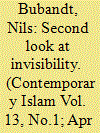|
|
|
Sort Order |
|
|
|
Items / Page
|
|
|
|
|
|
|
| Srl | Item |
| 1 |
ID:
164018


|
|
|
|
|
| Summary/Abstract |
The Arab concept al-ghayb refers to the hidden, the unseen, the invisible. The term encompasses a range of important phenomena in Islam and in the everyday experiences of Muslims. The dominion of the unseen (alam al-ghayb) includes those parts of reality that cannot be seen simply because they are covered by other visible objects. It also refers to those phenomena that by their nature cannot be perceived (e.g. the face or throne of God, paradise, hell, the past, or the future), as well as those objects that are blocked from view by one’s perspective (Drieskens 2006; Mittermaier 2011; Suhr 2013). Al-ghayb is important to the notion of barzakh, the intermediary realm between life and death; to the issue of veiling; to visions of deceased saints or dreams about the Prophet Muhammad as well as to the uncontrollable powers of jinn, angels, magic, the evil eye, and omens (Pandolfo 1997;
|
|
|
|
|
|
|
|
|
|
|
|
|
|
|
|
| 2 |
ID:
164025


|
|
|
|
|
| Summary/Abstract |
Spirits hold a central but ambivalent position in Indonesian political and social life. Pushed to the margins of public discourse in recent decades by modernism and Muslim piety, spirits remain key to the realm of the invisible or inscrutable (gaib) and continue to have a strong hold on the popular imagination in communities and on TV screens across the archipelago. One kind of spirit combines imagined potential and public ambivalence with particular force: jin spirits (also spelt jinn). Described in the Koran as real spiritual entities with an unfortunate habit of possessing humans, jin spirits are today also associated with heretical forms of Islam for many people with pious Muslim sensibilities and with backward superstition and evil magic for those with modern, secular sensibilities. Dealing with jin spirits, as a result, is always a careful negotiation with these cross-cutting sensibilities. This paper follows Kyai Muzakkin, the leader of an Islamic boarding school or pesantren in East Java, who insists that the one thousand jin spirits at his pesantren are real and effective “tools” at his disposal. I suggest that Kyai Muzakkin’s insistence on spirits as “tools” responds to the repressed and ambivalent reality of spirits in Indonesia. By turning tech-gnosis, the modern fascination with technology, into both ontological proof of and moral justification for the existence of spirits, Kyai Muzakkin harnesses the magic of modern technology – and of tele-technology in particular – in support of the reality of the invisible realm. While tele-technology thereby vindicates the reality of spirits and advocates for alternative ways of seeing Islam and the modern nation of Indonesia, I also argue that this vindication comes at a cost; namely the ambivalent re-inscription of visibility as proof of the real.
|
|
|
|
|
|
|
|
|
|
|
|
|
|
|
|
| 3 |
ID:
066181


|
|
|
|
|
|
|
|